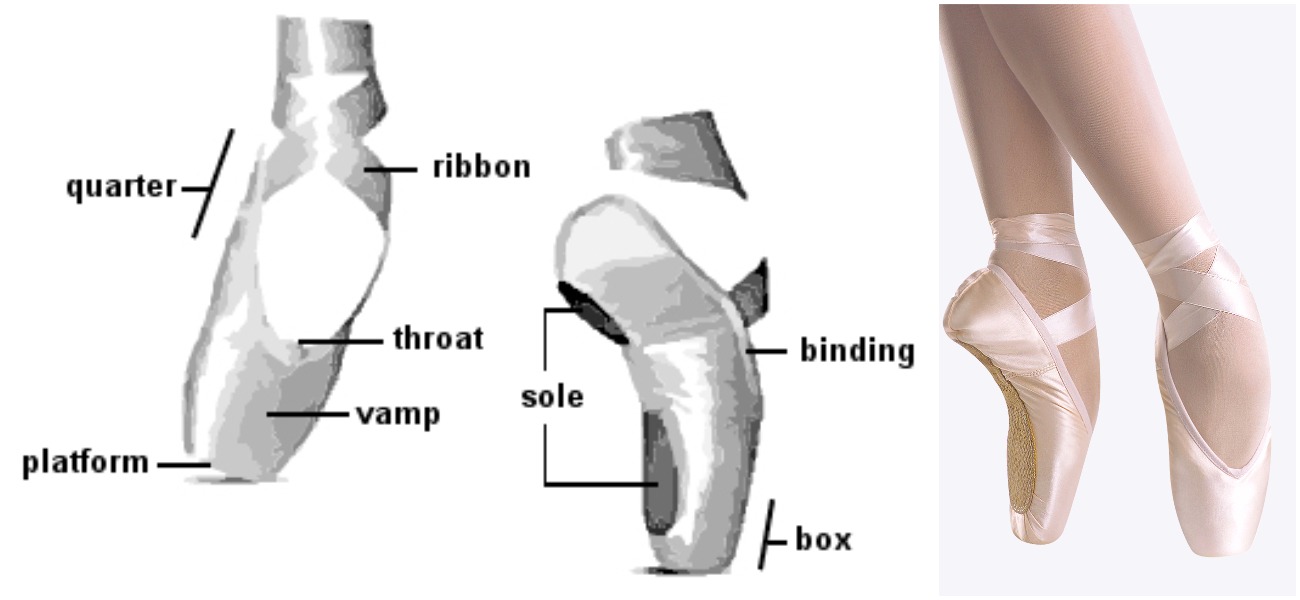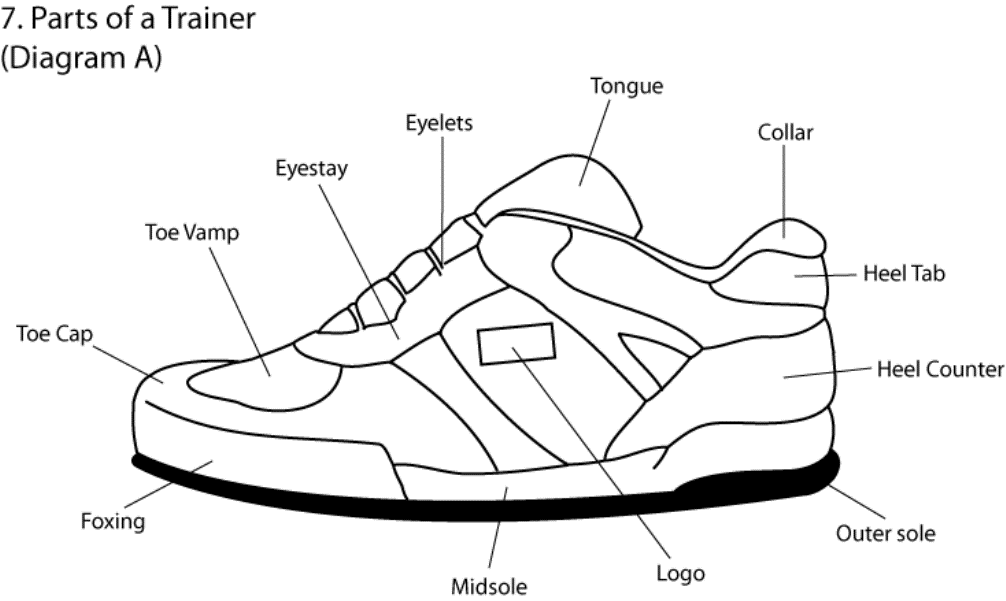
Everyone knows what a shoe is, whether they are sports shoes, running or dress shoe, they have become an integral part of our daily lives and we often look at it holistically; not always remembering that there are different parts of a shoe.
Previously, shoes were originally designed to offer protection against adverse weather, sharp objects, and uncomfortable surfaces. In fact, the earlier version of shoes was believed to have been a sandal of some sort form. However, the quality and the sophistication of these precious foot wears have improved drastically. Experts agree that fashion, too, played a critical role in the overall evolution of shoes. Perhaps this is because the human psyche usually craves for a unique individual identity. The upper classes saw shoes as a way of fulfilling this particular desire. As shoes got more and more expensive, leather, cloth, tapestries, and velvet began to be used as materials. Shoes are typically classified according to their use. As a result, we have those for sports, work, corrective and casual wear.
Parts of a Shoe
Today in this post we want to discuss in excruciating details, the parts of different types of shoes including, office, Pointe, high heel as well as running shoes. Read on and enhance your knowledge.
Parts of a Pointe Shoe
Pointe shoes are great shoes which allow ballet dancers to dance on their toes effortlessly and comfortably. Bearing in mind that each dancer has unique and different feet, Pointe shoes are available in varied styles, sizes, and shapes. However, even though these variations exist, their standard construction remains the same.
This particular type of shoe makes ballet dancing seem magical and daring as well. They create some form of lightness, giving a sense that the ballerina is floating on air! The tip of the shoe is typically a robust box made of densely packed layers of cardboard, fabric or paper hardened by glue. The remaining parts of the shoe are made of leather, satin, and cotton. Each shoe is usually custom made, hand crafted to meet the unique needs and specifications of individual dancer.

Shank: This is the sole section which supports the foot of the dancer. It creates some form of stiffness to the sole thus helping to create a fabulous arch.
Box: This part lies at the front section of the shoe, encasing the toes of the dancer. It is relatively flat on the front end, a feature which allows the dancer to find the much-needed balance. It is often made of layers of fabrics and paper glued together and sealed with satin.
Vamp: This area refers to the top end of the shoe and typically covers the top of the dancers’ toes. Along with the strength of the shank as well as the size of the box, the vamp’s length is critical to ensuring that Pointe shoes are well fitting. In some instances, dancers darn the surface of the box to allow it to offer sufficient traction.
Sole: It is attached to the bottom of your shoe. It is usually a small and thin piece of leather which is glued and expertly stitched on the edges.
Platform: This refers to the flat surface of the box which the dancer exerts all of her mass on.
Heel: This section encases the back foot of the dancer. As such, it should reach high up the back of your foot to ensure that your foot does not slip out.
Parts of an office shoe
A signature pair of well-designed office shoes is an essential possession. Having sturdy and a well-maintained pair of dress shoes is not a luxury but a necessity. Today, office shoes are equally available in a broad range of varieties, and one can always choose them according to his/her pocket, needs and preference.

Body: This is the section which is visible to view.
Vamp: It refers to the front part of the body. It covers the toes as well as a part of the instep.
Quarter: The rear section of the body that covers the heel.
Tongue: The primary purpose of this part is to offer protection against the debris. Most often, it varies in design and may be formed by the vamp or can be stitched into the shoes as well.
Counter: It helps to keep the shape of the shoe intact and is found in the heel.
Toe Cap: It is usually placed over the vamp and is made of either metal or leather.
Shankpiece: It is located between the outsole and the insole. The shank piece is designed from a wide range of materials. It is intended to support your feet and offer shape to the shoe as well.
Toe Box: This zone is critical for comfort. Besides, it provides protection, structure, and form to your toes.
The Sole: It is the bottom section of the dress shoe and is made up of three sub-sections, including the outsole, midsole, heel, and insole. The outsole is the bottom visible part and is usually made of rubber or leather. It provides protection, stability, and grip. The midsole is found at the center of the sole and adds to the thickness thus giving the shoe a sturdy look. The insole holds the other pieces into position and is connected to the pump via staples, glue or stitching.
Heel: Whether low or high, this section is attached to the outsole and offers height and balance.
Parts of high heel shoes
High heels are designed in such a way that they elevate the height, elongating the legs thus adding an appealing flair to just about any outfit. These are the parts of high heel shoe:

Toe Box: This is what houses your feet. When purchasing high heel shoes, it is imperative to ensure that all your toes fit comfortably and have adequate space to spread out in the toe box.
Insole lining: Somehow self-explanatory, it refers to the lining of the sole of high heel shoes. Some insoles are sewed while others are usually glued into the shoe. When looking to buy this particular type of shoe, you should always ensure that the insole is attached to the shoe properly. If it is glued, there should be no peeling or any visible gaps.
Read: A Guide on the Best Shoes For Plantar Fasciitis
Sole: The sole of high heel shoes should be made of rubber to help prevent occasional slipping by offering adequate traction.
Heel: This is the part that makes high-heeled shoes entirely different from the rest. The height of the heel often varies between half an inch to seven or eight inches. Top-end heels are equipped with a metal stake inside, intended to offer durability and the strength to hold most body types and sizes.
Parts of a running shoe

There are lots of potential benefits of running. According to a particular study, running can help lower blood pressure, reduce body weight and can also increase the capacity of your lungs. Even though the types of devices required by runners are somehow limited, a decent pair of running shoes is a necessity. Shoes for running not only provide incredible midsole cushioning but they also aid in injury prevention, offer arch support and most importantly, enhance athletic performance.
Upper: Just like the other types of shoes, it is the section which is visible. It contains the collar, tongue and the laces. When shopping for running shoes, go for an upper made of breathable mesh which can help increase the ventilation around your feet.
Tongue: It is the middle section of the upper and moves out and up to enable the foot to slide into the shoe. It is cushioned to offer comfort under the laces. Trail-running and hiking shoes usually feature gusseted tongues to prevent both moisture and debris from entering.
Eyelets: These are the perforations on the upper where laces thread through.
Collar: This refers to the section of the upper which surrounds your ankle. You should go for collar cushioned with mesh for both moisture-wicking and breathable functionality.
Don’t Miss: 12 Best Basketball Shoes For Outdoor Performance
Toe cap: It protects the toe bumper from any form of impact.
Quarter panels: These are the sections of the upper sides of the shoe. They usually feature reinforcing overlays which offer additional protection, durability as well as torsional stability.
Heel tab: Located slightly above the heel counter.
Heel counter: Situated below the collar and designed to form the shape of the heel as well as holding the shoe in place.
Sockliner: A retractable part which sits on top of the midsole. It provides cushioning support and comfortability.
Midsole: For a running shoe, this is perhaps the most important part. It is found below the insole and above the outsole. They provide support during running and can also absorb shock.
Outsole: This part is incredibly important as well and is located at the bottom of the running shoe. Not only does it offer extra support, flexibility, and traction but it equally acts as a shock absorber.
See also: 14 Comfortable Hiking Boots For Men and Women
The Bottom Line:
The prospect of knowing and understanding the different parts of a shoe together with their functions can potentially make it relatively easier for you to choose the best product based on your needs. Whether you are seeking for office, high-heeled, running or Pointe shoes, we have given you a detailed description of all the parts you need to know.




